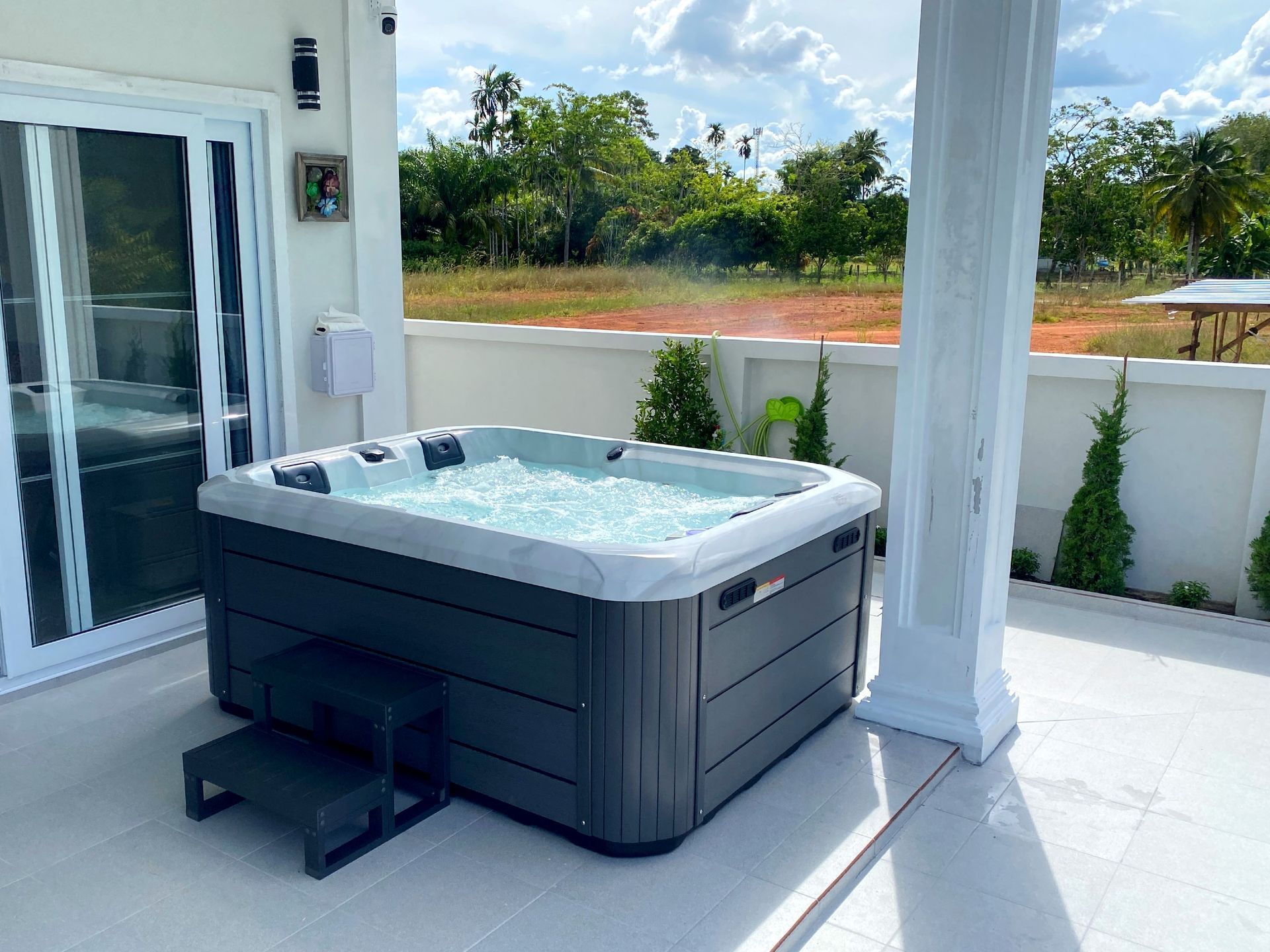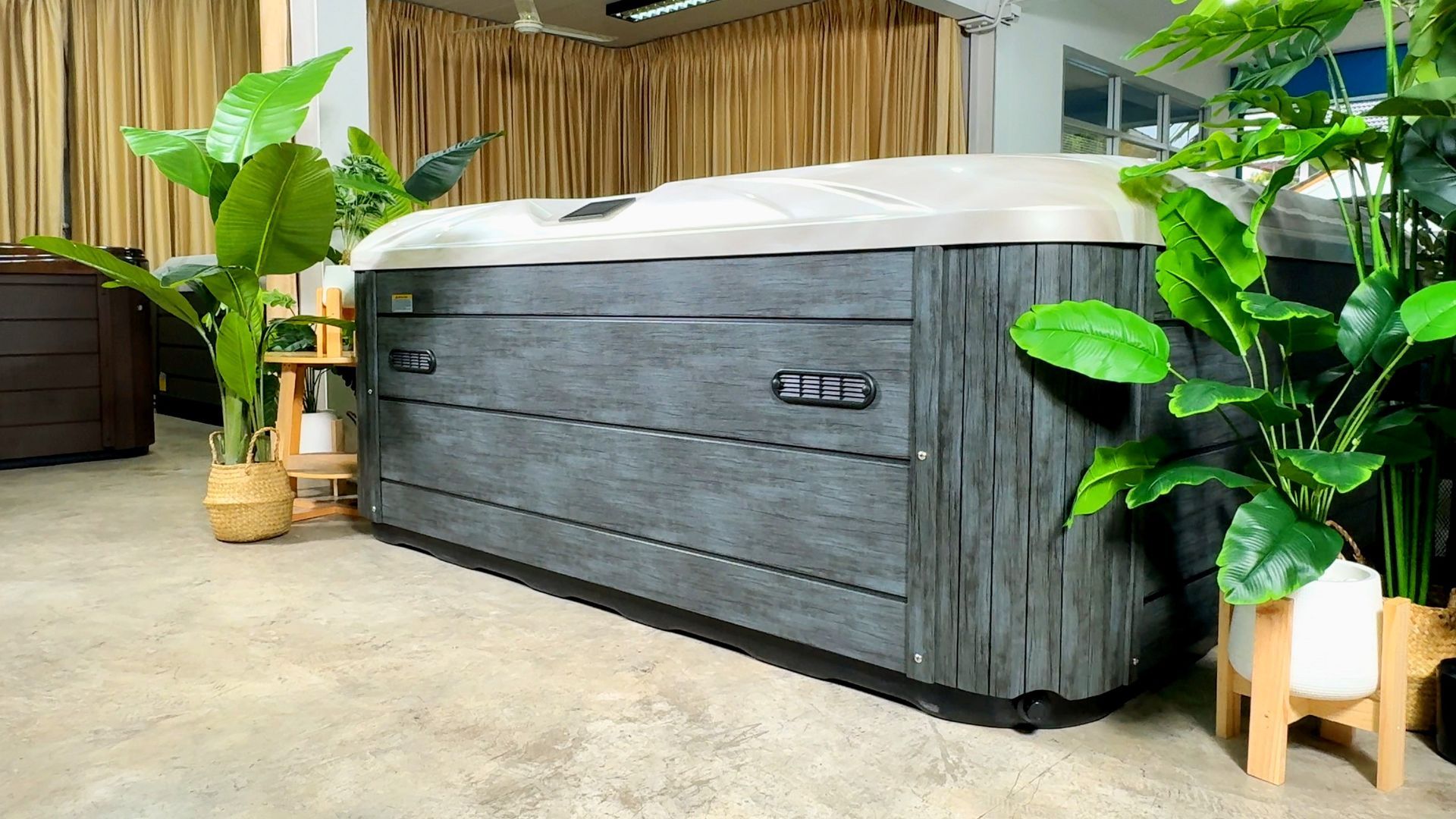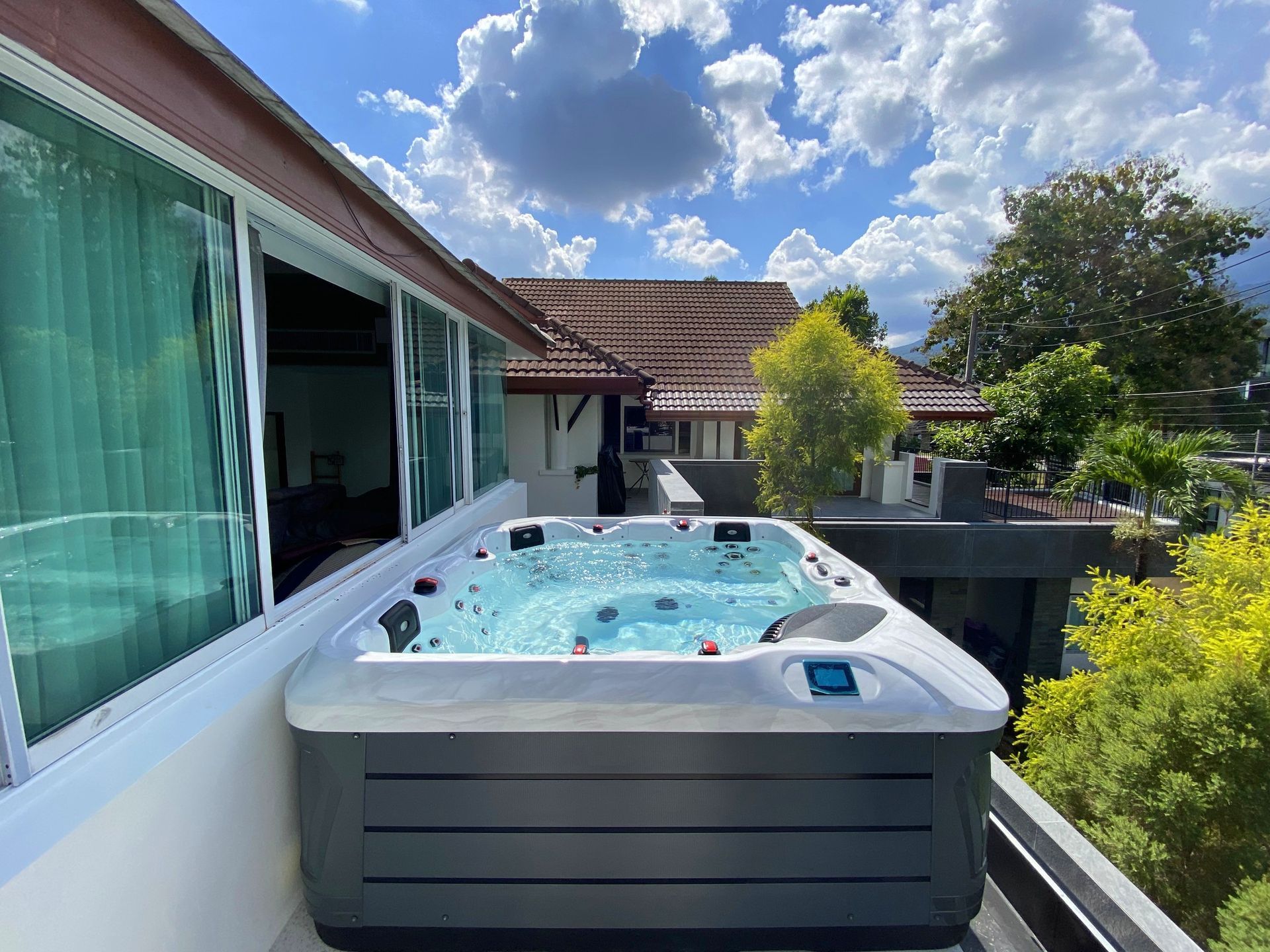8 Differences Between Hot Tubs and Bathtubs
8 key points to help you tell a bathtub and a hot tub apart.
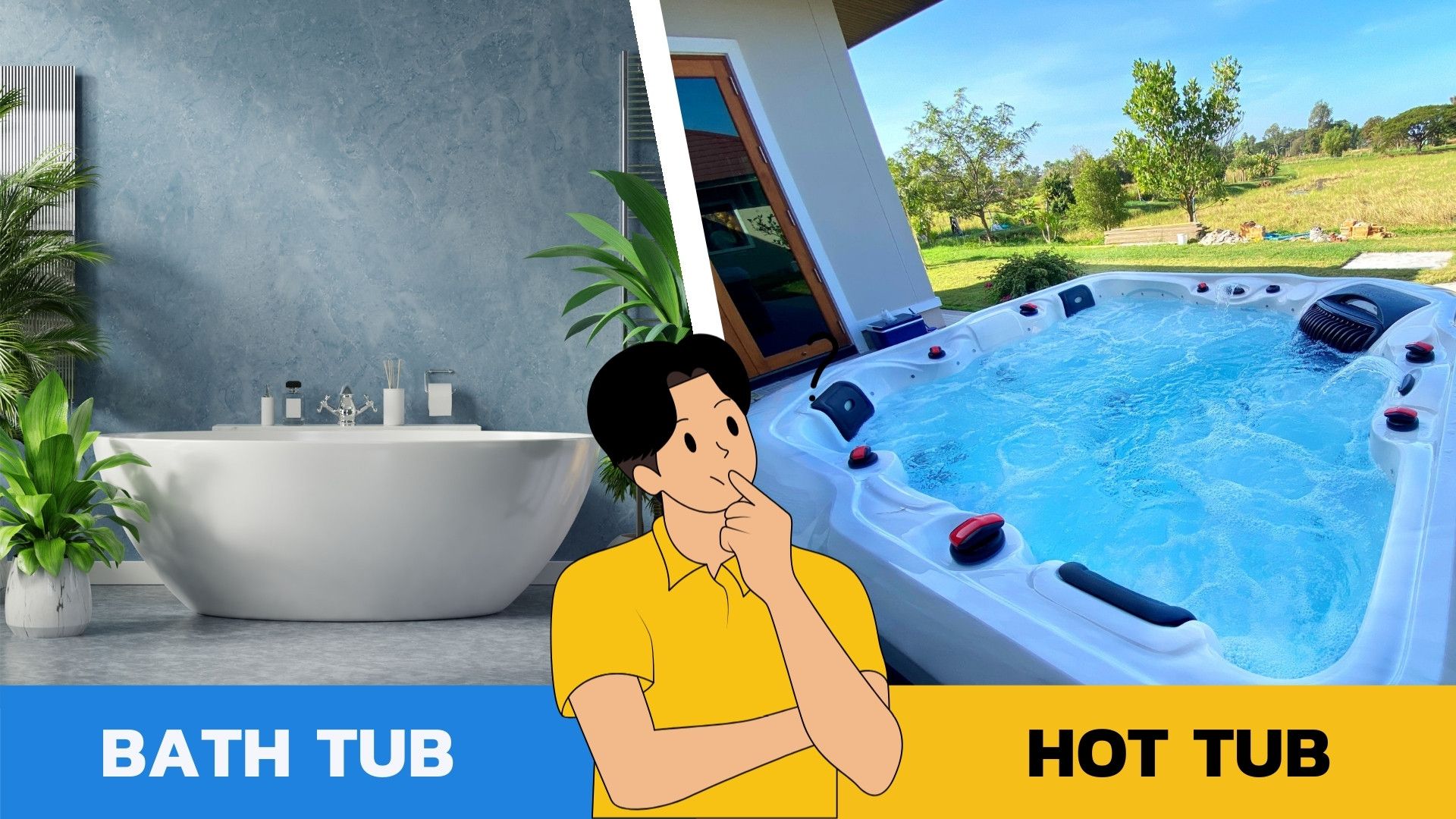
Overview: Hot Tub vs Bathtub
In this article, Q&G provides information for anyone shopping for a tub to install at home—creating a relaxing atmosphere in place of trips to hotels and resorts during the COVID period. Tubs on the market today generally fall into two categories:
Hot tubs (also called “hot tubs” or “spas”) and bathtubs.
When you’re building or renovating a home, having the right information makes it easier to choose a tub that truly fits your needs and budget. Understanding the differences between bathtubs and hot tubs explains why these two products differ in functions, features, and price.
Quick Comparison Table: 8 Key Differences
- Purpose of use
- Water usage
- Heating systems
- Massage systems
- Water depth
- Size & capacity
- Installation environments
- Maintenance & care
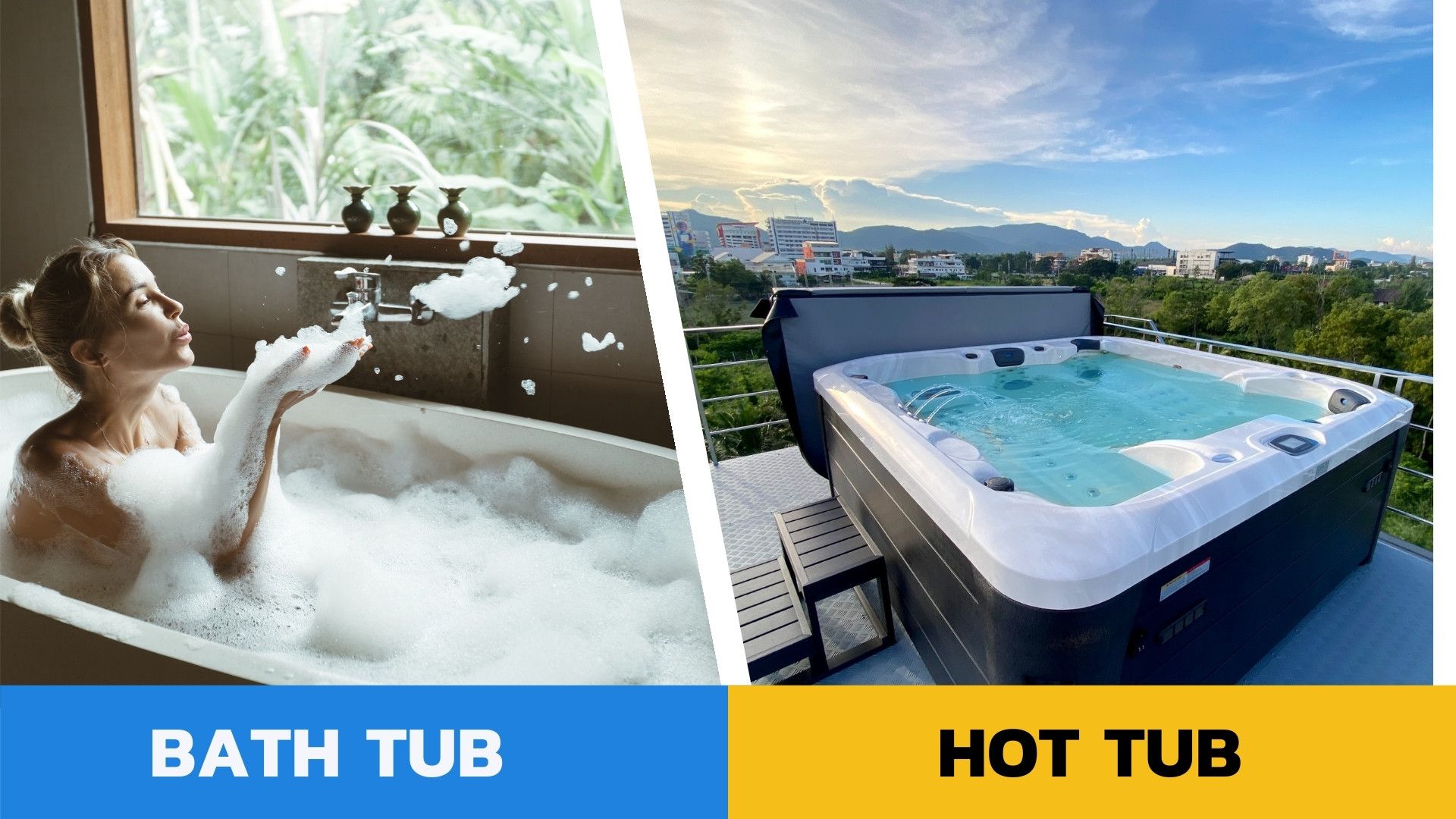
1) Bathtub vs. Hot Tub: Different purposes

🫧 Bathtubs are designed for “bathing.” 🫧
That means you can use body-care products directly in the tub—soap, shower gel, body wash, foaming products like bath bombs, as well as skin-care additives such as milk, mineral powders, or herbs. Besides basic washing, bathtubs are also for soaking with these products.
♨️ Hot tubs are designed for “soaking.” ♨️
You soak in plain hot water—no additives—to gain health benefits from warm water. Hot tubs heat water up to 40 °C (a temperature range safe for older children through seniors). Benefits align with hydrotherapy principles: better sleep, relief of joint pain, easing muscular tension, overall relaxation, relief from aches in various parts of the body, improved mobility, stimulation of the immune system via enhanced blood circulation, and reduced stress.

2) Bathtub vs. Hot Tub: How the water is used
🫧 Bathtubs: drain and refill every use. 🫧
Because soaps and skin-care products go in the water, you drain the tub after each session and refill with fresh water for next time.
♨️ Hot tubs: drain and refill about every 3 months. ♨️
Since the purpose is different, hot tubs reuse the same water and keep it ready 24/7. For private/family use, the same water can typically be used for up to three months.
Why can hot tubs reuse water?
- Automatic, scheduled filtration cycles
- Ozone sanitation to remove algae, biofilm, dirt, and contaminants from bathers
- Supplemental chlorine disinfection (milder than what’s used in typical public pools)
Correct hot-tub usage
💧 Shower before soaking—just like at an onsen—to keep sweat, lotions, sunscreen, deodorants, serums, and oils out of the tub.
💧 Wear swimwear.
If you wear regular clothing, it must be a dedicated set washed without detergent to prevent foam. Detergent suds aren’t captured by the filtration/sanitation system and will burden maintenance. Proper swimwear helps keep water clear and reduces water-care time.
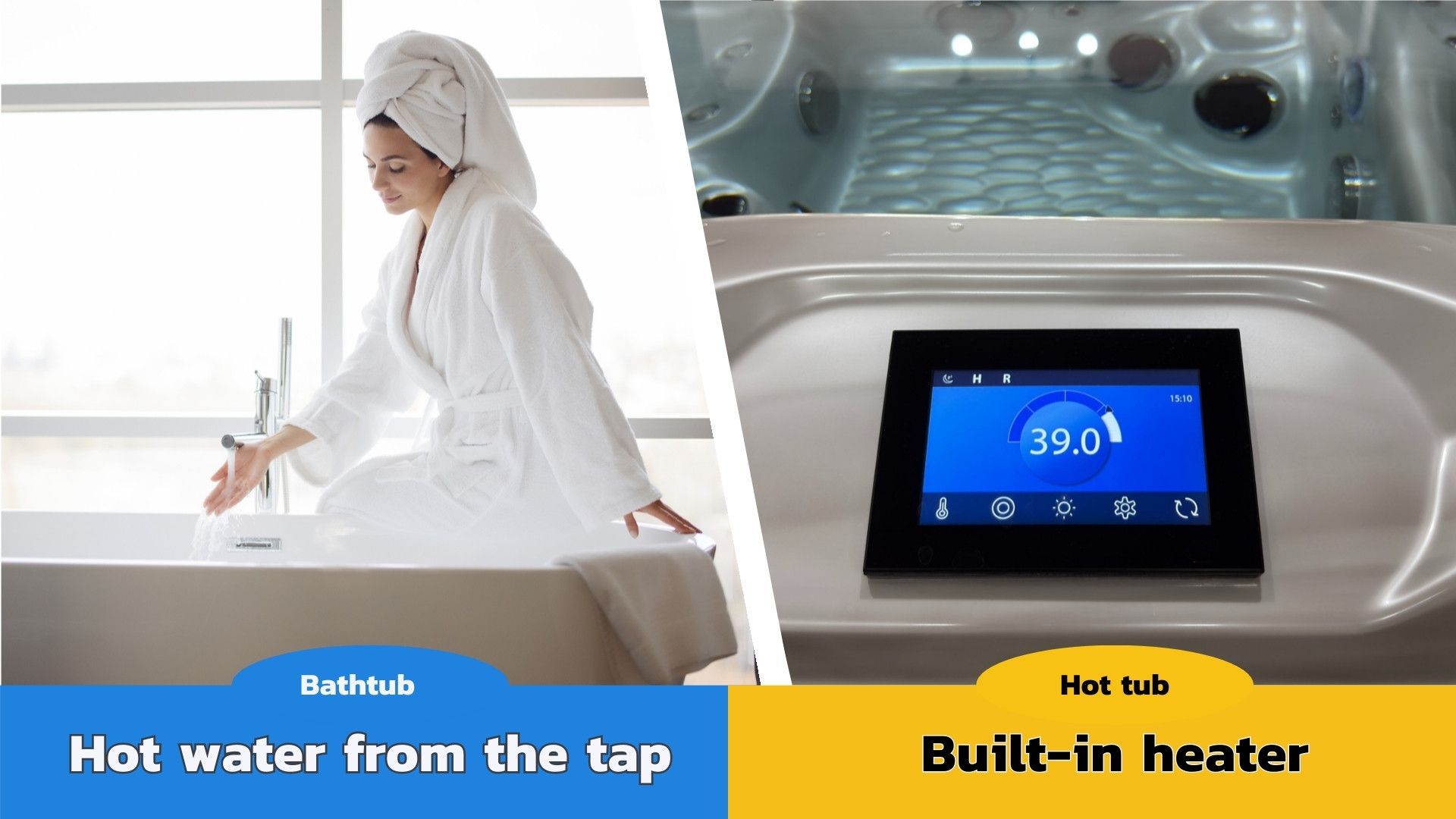
3) Bathtub vs. Hot Tub: Different heating systems
🫧 Bathtubs use external hot water from a heater/boiler. 🫧
You fill the tub from a hot tap or shower when you want to bathe.
🔵 Bathtubs don’t maintain temperature. 🔵
They’re filled and used on the spot.
♨️ Hot tubs have built-in heaters. ♨️
You can select and display the water temperature on a control panel and adjust it as desired. If you set 40 °C, the tub will keep that temperature day and night, so your preferred heat is always ready.
🔴 Smart temperature control, steady heat 24 hours. 🔴
- The heater doesn’t run constantly; it cycles only to maintain the set temperature. Electricity use is therefore controlled rather than continuous.
- Older hot tubs: Users often guessed water temperature by feel when mixing hot and cold.
- Modern hot tubs: Let you set an exact temperature.
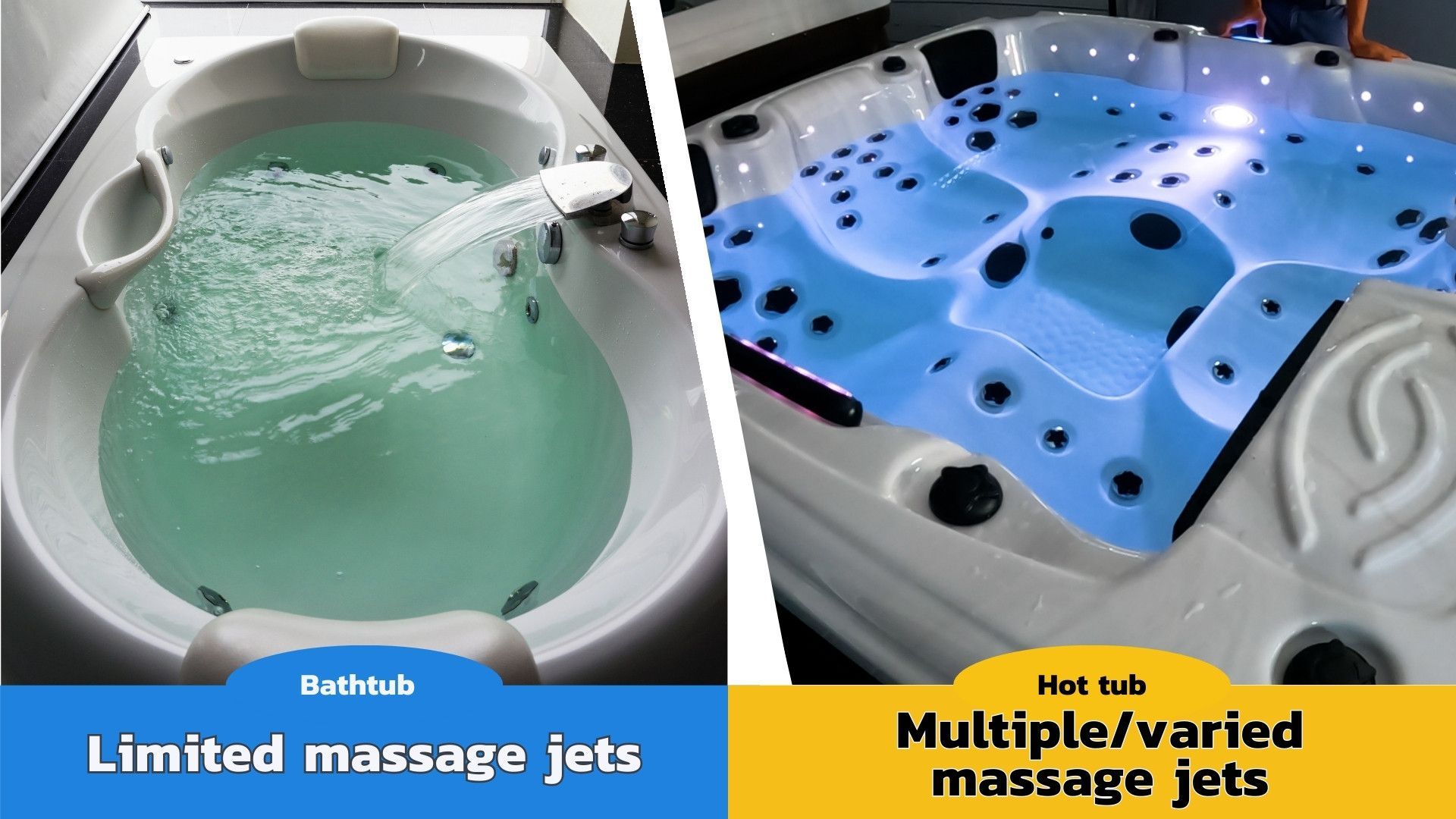
4) Bathtub vs. Hot Tub: Different massage systems
🫧 Bathtubs place massage features along the sides and floor. 🫧
🔵 Using jet massage and air-pressure (air-jet) massage. 🔵
Because of size and depth limits, bathtub jets usually target only 1–2 areas (e.g., calves, thighs, waist, or lower back). The effect is modest compared with a hot tub.
🔵 Most bathtubs emphasize air-jet systems. 🔵
Air pumps create bubbly sensation and ambience but provide gentler massage than water jets. Typical bathtubs have about 4–8 jets, usually small to medium, often without per-jet strength adjustment.
♨️ Hot tubs let you configure both water jets and air-jet massage. ♨️
🔴 Higher-end hot tubs often use 100% water jets throughout. 🔴
Jet placement targets specific muscle groups: neck, shoulders, mid-back, lower back, hamstrings, calves, and even the soles of the feet, using medium and large jets for effective muscle work.
🔴 Hot tubs have many more jets. 🔴
For example, a 2.0 m × 2.0 m hot tub for 4–5 users may have 40–60 massage points, depending on the model.
With multiple seats and loungers, each position offers different jet patterns to cover the whole body. You can also adjust intensity with air-control valves and diverter valves, and activate only the zones you want—e.g., focus on neck and shoulders.

5) Bathtub vs. Hot Tub: Different water depth
🫧 Bathtubs average 30–45 cm deep. 🫧
Depending on the model, when seated the water usually reaches from the abdomen to mid-torso. Depth is typically uniform (e.g., 30 cm throughout).
♨️ Hot tubs average 55–65 cm deep. ♨️
A single hot tub often provides multiple depths, commonly:
- mid-chest,
- up to the shoulders
- up to the neck—thanks to different seats and loungers designed for health benefits.
♨️ Why depth matters for health ♨️
Greater depth increases buoyancy, offloading joints and enhancing circulation. Deeper soaking also promotes superior relaxation—your body feels lighter during and after a session.
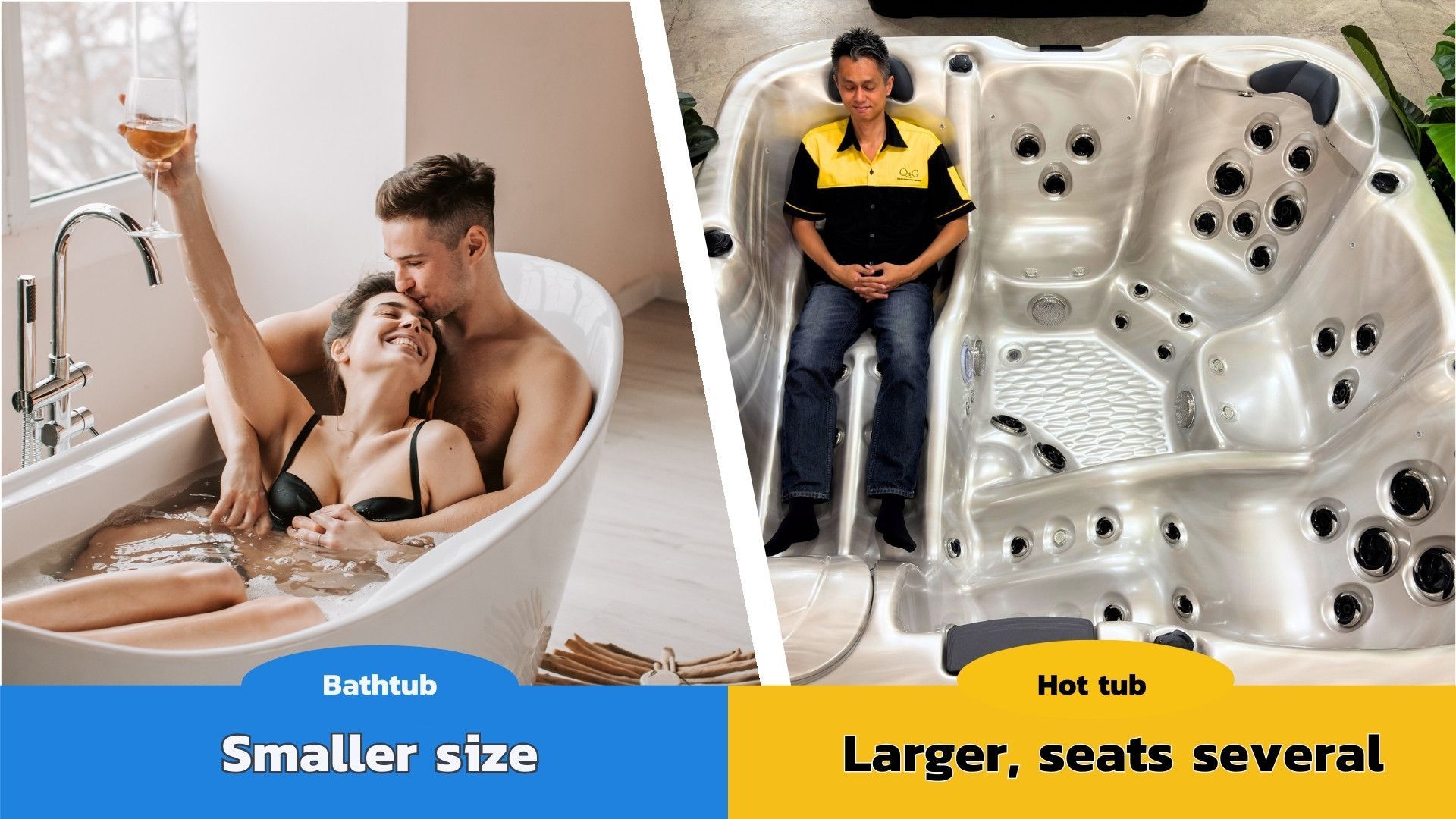
6) Bathtub vs. Hot Tub: Size and capacity
🫧 Bathtubs are compact for personal use. 🫧
Typically for one person (up to two). Length is usually 120–190 cm (only a few exceed 200 cm), so many users can’t fully stretch out and must sit or recline with bent knees. Width is around 75–150 cm, which can feel confined—especially in “two-person” bathtubs that still have limited interior space.
♨️ Hot tubs have larger, more usable interiors. ♨️
Even a 2-person hot tub is commonly 2 m long or more, allowing full stretch and comfort. Outdoor models often accommodate 4–6 people at once, with some sized for up to 10 users depending on the model—perfect for soaking with family, a partner, or friends.
Interiors feature multiple loungers and seats for varied views and distinct massage layouts at each position.
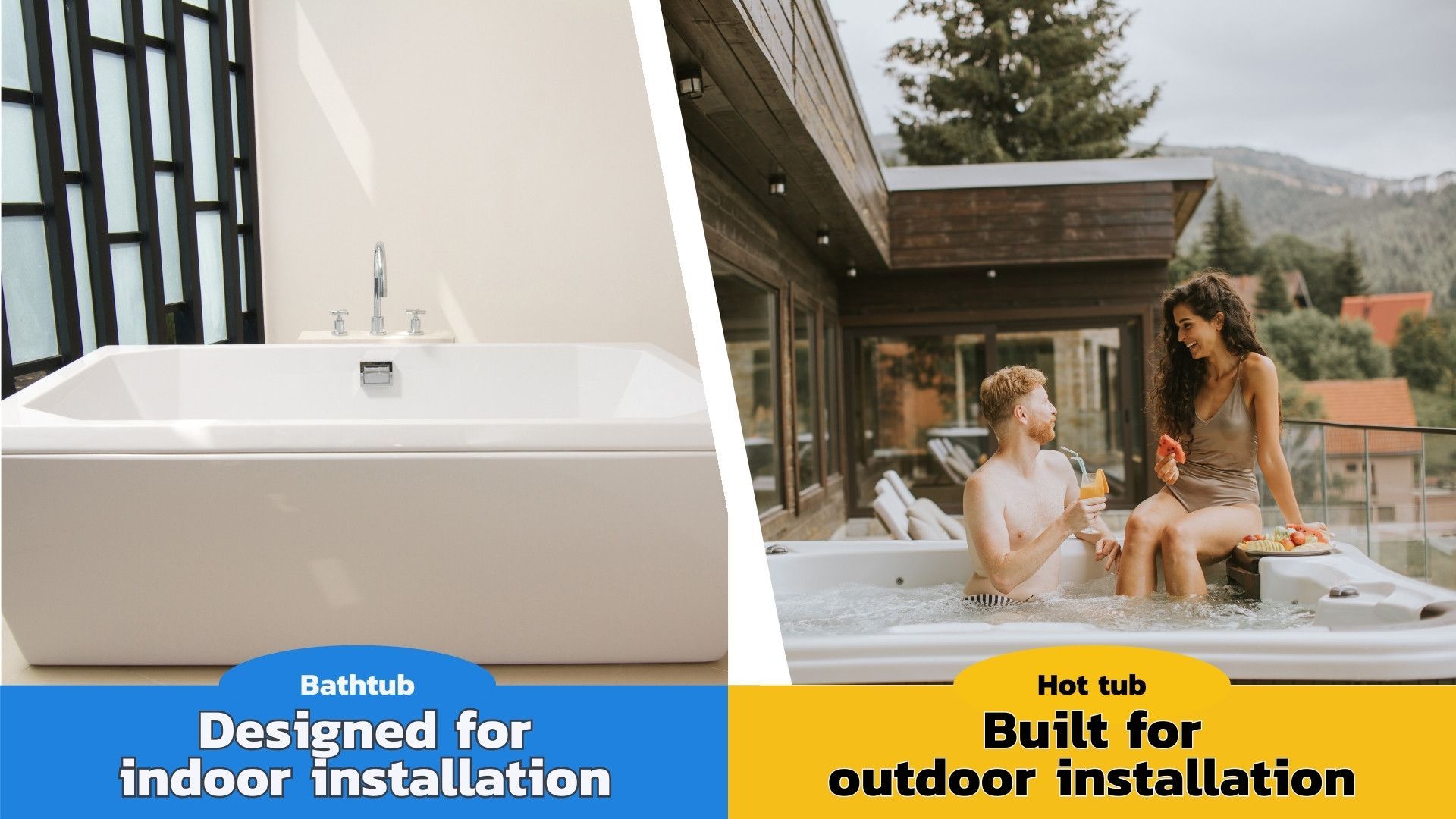
7) Bathtub vs. Hot Tub: Installation environments
🫧 Bathtubs are built for indoor installation. 🫧
🔵 Usually placed in bathrooms, wellness rooms, or near saunas. 🔵
Materials vary: fiberglass with gel-coat, ceramic, acrylic, cast stone/solid surface, steel, wood, marble, or copper.
🔵 Most bathtub materials aren’t made for direct outdoor exposure. 🔵
Without UV protection, outdoor exposure can lead to surface cracking, swelling, and leaks.
Yes, you may see semi-outdoor or outdoor-placed bathtubs at resorts—on balconies by the sea or on decks in mountain settings—but expect shorter service life. If you plan an outdoor bathtub at home, factor in earlier replacement, since many materials will weather beyond repair over time.
♨️ Hot tubs are purpose-built for outdoor installation. ♨️
🔴 Reinforced structures with fiberglass provide exceptional strength to support water and bathers, preventing leaks. 🔴
The visible shell layer is high-grade acrylic—more heat-resistant and dimensionally stable than typical bathtub acrylic—engineered specifically for outdoor use.
🔴 Outdoor-ready component engineering. 🔴
Piping, control buttons, circuit boards, heaters, jets, valves, pumps, structural framing, synthetic wood skirts, and the base are designed for weather resistance. For example, the synthetic wood cabinet isn’t just aesthetic—it helps keep rainwater out of the equipment bay beneath the shell, protecting pumps, heaters, controls, and support structures.
Proper bases under the tub also protect the structure and electrical systems from ground moisture, extending service life.

8) Bathtub vs. Hot Tub: Maintenance and care
🫧 Bathtubs need regular surface cleaning after use. 🫧
🔵 Why bathtubs get yellowing or stains 🔵
Over time, bacteria, biofilm, and microorganisms accumulate, leaving tide marks at the typical waterline and yellowing across the surface. Hard-water deposits (e.g., limescale, mineral scale) plus residues from bath additives worsen the appearance. Restoring a bathtub often requires chemicals to refurbish the surface or hiring a specialist cleaning/repair service.
🔵 Bathtub surface repairs may be necessary. 🔵
Any material can degrade: water exposure, chemical reactions, and buildup from bath products can cause discoloration, flaking, or cracks in the finish, requiring re-coating or refinishing.
🔵 Don’t forget the internal plumbing. 🔵
Because bathtubs are drained after each use—and you add soaps, creams, mineral powders, etc.—residues accumulate inside jet and circulation pipes. If you don’t perform periodic pipe cleaning with appropriate chemicals, biofilm and algae can purge into the tub when you run the jets.
🔵 Structural issues: cracks, bulging, leaks. 🔵
Bathtubs are usually built with modest thickness to keep size and cost down; long-term use may cause shell cracking and leaks.
- Wooden tubs can shrink and leak if left dry for long periods.
- Acrylic tubs reinforced with plastic may need backing repairs.
- Fiberglass tubs may require fiberglass patching.
🔵 Repair cost considerations. 🔵
Many bathtubs are built-in (sunken in concrete, tiled around). Structural leak repairs can involve demolition and reinstallation, plus plumbing rework. Owners should anticipate potential renovation costs down the road.
♨️ Hot tubs use anti-microbial surface technology. ♨️
🔴 Why Q&G hot tubs are easy to care for and stay like new. 🔴
Q&G uses acrylic surfaces with anti-microbial technology that resists microorganism growth within the surface layer, reducing heavy surface maintenance. You won’t see typical waterline scum; hard deposits like limescale don’t bond readily, and—crucially—the filtration system keeps water clean to support both hydrotherapy and day-to-day soaking quality.
With premium outdoor-grade acrylic (approx. 3 mm shell thickness), there’s no need for periodic surface re-coating even after long-term use.
🔴 Automatic, scheduled filtration cycles circulation and sanitation keep water ready. 🔴
Ozone plus chlorine and daily automatic filtration return clear water to the tub and clean the internal pipework as part of routine operation. Unlike bathtubs, you generally don’t need separate plumbing cleanouts during regular, long-term use.
🔴 Proper user habits lower costs and extend lifespan. 🔴
Always shower before soaking and never add soaps, foaming agents, or onsen powders. This prevents residue in the plumbing, reduces maintenance time, and gives you a cleaner, skin-friendly soak free of slime, mold, algae, and bacteria.
🔴 Hot tubs last longer. 🔴
One-piece shells reinforced with fiberglass support water weight and structure on their own, reducing leak repairs compared with bathtubs. Hot-tub plumbing is generally higher-grade: flexible heat-resistant hoses, clamped jet fittings (not just glued), and high-strength solvent cements that withstand pressure and heat.
🔴 Service access is straightforward. 🔴
With removable synthetic-wood side panels, Q&G technicians can access the equipment bay to replace parts quickly—provided the tub is installed per Q&G guidelines.
⬭⬭⬭⬭⬭⬭⬭⬭⬭⬭⬭⬭⬭⬭⬭⬭⬭⬭⬭⬭⬭⬭⬭⬭⬭⬭⬭⬭⬭⬭⬭⬭⬭⬭⬭⬭⬭⬭⬭⬭⬭⬭⬭⬭⬭⬭⬭⬭⬭⬭⬭⬭⬭⬭⬭⬭⬭⬭
Conclusion
Bathtubs and hot tubs serve different goals. A bathtub is ideal for bathing with soaps and skin-care additives, lives indoors, and is typically shallower and smaller, with water drained after each use.
A hot tub is built for soaking in plain, temperature-controlled water (up to 40 °C) with targeted hydrotherapy jets, is deeper with multiple seats/ loungers, and is engineered for outdoor installation. Water is kept clear via automatic, scheduled filtration cycles with ozone and a mild chlorine residual, so it’s ready when you are.
Choose a bathtub if you want occasional relaxing baths and product rituals inside the bathroom. Choose a hot tub if you value daily recovery, better sleep, muscle and joint relief, and social soaking outdoors with set-and-forget temperature control.
If you’re still weighing options, list your must-haves (users, frequency, preferred jet zones, space, power, base). Q&G can help compare models, plan installation, and set up a simple care routine—so you get the right tub for your home and long-term budget.
Q&G hopes this article helps you distinguish and understand the uses of bathtubs vs. hot tubs. Thank you for your interest in hot tubs—wishing every reader strong body and mind!
Contact :
Email : Ask.QandG@gmail.com
phone number : 087-816-6383
Discover Outdoor Hot Tubs at
QandGTub.com




